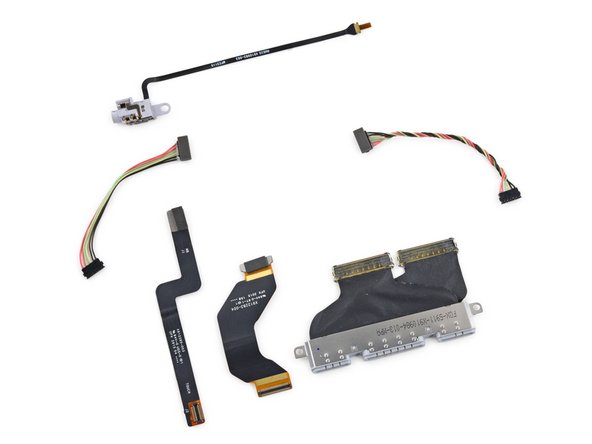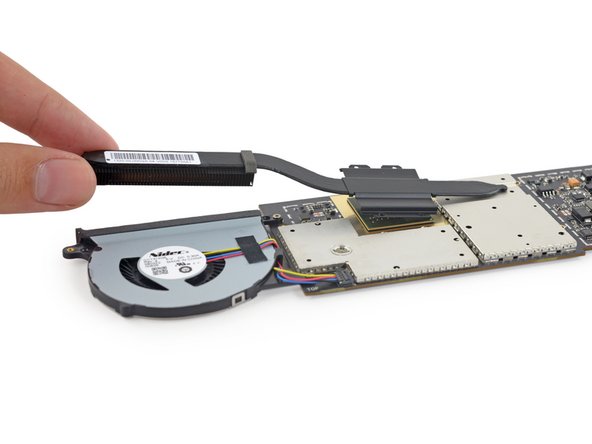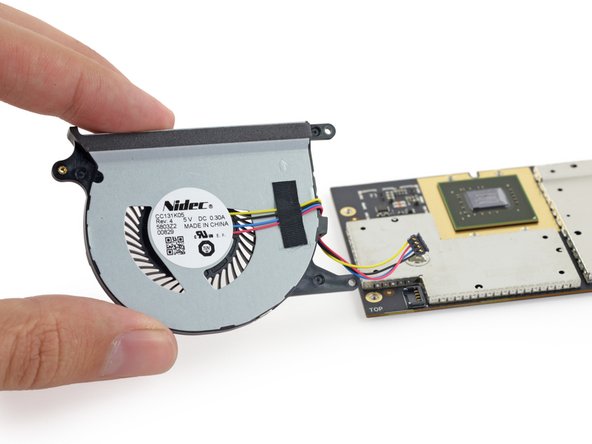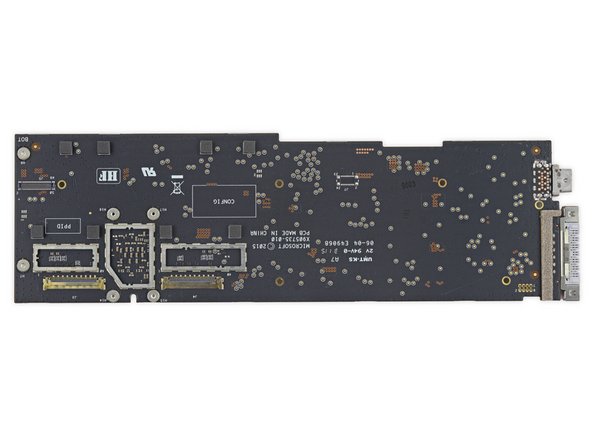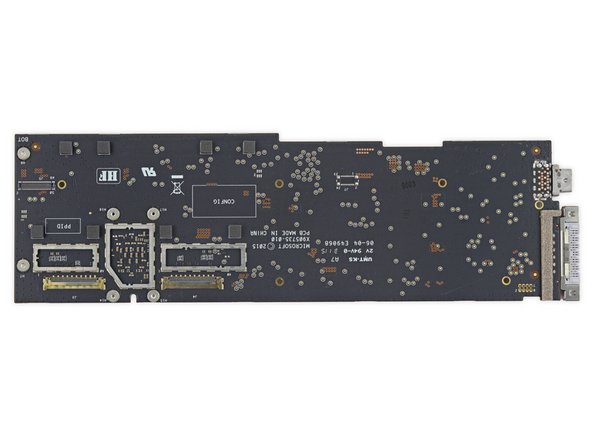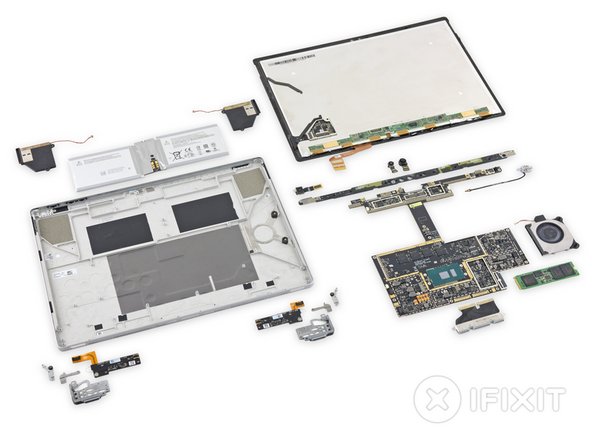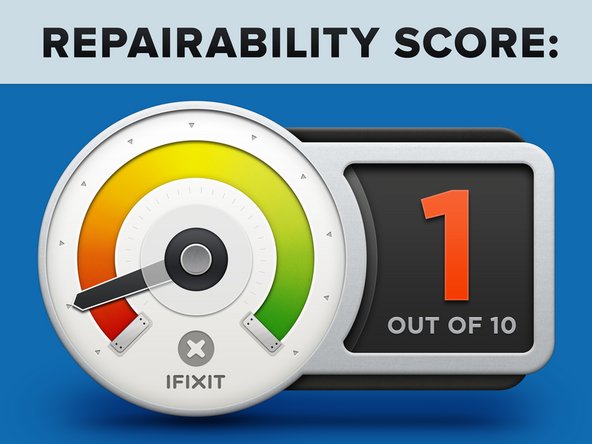Introdução
Just last week we tore down the Surface Pro 4, the tablet that can allegedly replace your laptop. Today we've got the Surface Book, a laptop that can, ehrm, replace the tablet that replaced your laptop. It's the first ever notebook from Microsoft, and with its trick detachable display and pressure-sensitive Surface Pen, it defies categorization—but not teardownification. Join us as we dismantle the Surface Book!
Teardown season is heating up—follow us on Instagram, Twitter, or Facebook for all the latest!
O que você precisa
Vídeo de Apresentação
-
-
Just what is a "surface book"? We check the specs for clues:
-
13.5” PixelSense multitouch display, with 3000 x 2000 resolution (267 PPI)
-
6th Gen Intel Core i5 with dedicated NVIDIA GPU
-
8 GB RAM
-
128 GB solid-state drive
-
802.11ac Wi-Fi + Bluetooth 4.0
-
8.0 megapixel rear-facing camera with 1080p video + 5.0 megapixel front-facing camera
-
Surface Pen with 1,024 levels of pressure sensitivity
-
-
-
"Lift-off in T-minus 3...2... oh wait—the battery's low."
-
What separates the Surface Book from the competition is the fact that (usually) you can separate it quickly, with minimal disruption to your work. Other devices tend to require you to power down every time.
-
Now that we've achieved separation, we might as well reconnect it, but backwards!
How did you override the low battery lock? My clipboard battery is not being charged by the base, so I want to remove it and try to charge it directly.
If you take a paperclip you can push open the grip manuell, best way go into the 6th hole form the bottom on the left side.
By roughly an angel of 45. then you can loose one side and the other follows .
-
-
-
Glancing over the top of the display, we're greeted by a familiar face.
-
Like the Surface Pro 4, the Book's forward sensor array features an IR sensor, 5 MP camera, microphone, and ambient light sensor.
-
Likewise, we find an 8 MP, 1080p camera and microphone combo on the rear of the display, matching the hardware on the back of the Surface Pro 4.
-
-
-
We know our way past this display. It may be a bigger (and seemingly more flexible) pane of glass than we saw in the Surface Pro 4 teardown, but it opens with the same password: iOpener.
-
The glass thickness measures in at 0.4 mm, the same as on the Surface Pro 4.
Do you open from the glass side or the bottom side? It's hard to see which side is facing up in the image.
I finally found a supplier for anyone who wants to repair a cracked screen
I had no luck with the above supplier, and tried two other suppliers for that same aftermarket screen. The one that I finally received was defective - the touch didn't work at all and the screen had lines all over it. Finally found one on eBay, available in the united states, identical to the original one and works great! Be wary of the aftermarket ones - the one I received was also missing the metal piece for the display cable clip to re-attached. It is hard to find a good one, I hope that in the future they will be more available and easy to get a hold of.
FYI, for anyone who is looking for a good working replacement screen, the seller that I purchased my replacement screen from has more available now, so they are becoming much more easy to get ahold of! and they are very well priced. If anyone is interested, the seller name is "cknappsalesinc" on eBay. They are located in the united states, and of all the replacement screens that I tried to buy (as mentioned in my previous post) they were the only ones that actually delivered a working identical replacement that wasn't missing any parts and worked 100 percent on the first try (and is still working with no issues six months later!). Don't buy any of the after market ones from China! They are missing the bracket for the display clip and may not even work on arrival as was my experience.
-
-
-
Never one to judge a Book by its cover, we're glad for a chance to peek under the, um, lid.
-
Right away, we notice two cables tethering the display to the motherboard. Fortunately, they're conveniently located along one edge—meaning we really can flip this thing open like a book—and we easily dispatch their press-on connectors.
-
Unfortunately, these cables lead directly under the motherboard, which looks to be upside-down.
-
We do get a look at a small fan channel, which pairs with matching foam on the back of the display to direct the air just so.
-
-
-
Peeking out from beneath protective shielding, we find a chipset similar to that of the Surface Pro 4 display:
-
N-trig DS-D5000 touchscreen row driver (likely)
-
N-trig DS-A5048 touchscreen line driver (likely)
-
Novatek NT71394MBG timing controller
-
Macronix MX25U4033E 1.8 V 4.0 Mb multi-in, multi-out serial NOR flash memory
-
Rohm BD81028 LCD gamma voltage generator
-
Rohm BD8184MUV LCD power supply
Hi!
The ribon cable that we look on step 8 is torn : is my screen dead? Just the touch-sensitive feature? Can i repair it?
Thanks.
Que tal, necesito conseguir esa plaquita que va detrás de la pantalla pegada, la que tiene forma semi-cuadrada que tiene una tapadera metálica encima. jairocamposgt@gmail.com
-
-
-
Peeling up a thin foam layer confirms our suspicions—the motherboard is indeed upside down—smooth back up top, connectors and chips on the bottom.
-
Surprisingly, said motherboard also sprawls throughout the entire chassis, resembling some kind of nightmarish Tetris piece.
-
What's more, there's no sign of connectors for any of the peripheral components.
-
At least the camera bar comes up without any trouble. Maybe we'll find some tasty treasure below.
The face down motherboard puts the CPU heatsink on the back side of the tablet (against the metal casing) to improve heat dissipation. That sounds like a better reason than flat support for the display panel.
C'est effectivement ce qui semblait le plus logique à faire, surtout lorsque l'on découvre le dissipateur thermique utilisé pour le processeur, ainsi que son ventilateur. Je suis curieux de connaitre les températures du modèle core i7...
What are the ribbon cables on top of the sensory array? I was told they were the wifi antennas, but I messed my screen up and ended up tearing up the ribbon when removing. What do those ribbons do?
-
-
-
It's time to begin some Surface excavation!
-
The front-facing camera and IR sensor are glued to the chassis and trapped beneath the motherboard assembly, which makes for some tricky prying.
-
Next, we tackle tons of troublesome tape and deftly disconnect a tangle of connectors.
-
We arrive at the headphone jack, only to find that it's connected to the underside of the motherboard assembly by a lengthy cable.
-
-
-
-
With the motherboard sunny side up, we take a moment to pull out its brushless, 0.5 Amp fan.
-
Eager to get a taste of that sweet, sweet silicon, we also relieve the motherboard of its sprawling heat sink.
-
The cooling system in the Surface Book bears a passing resemblance to the large copper plate tucked against the battery of the Surface Pro 4, but covers silicon instead of Li-ion.
-
-
-
Having done their time, the front-facing and infrared cameras are plucked from their prison by a pair of our favorite tweezers.
-
Grateful for our assistance, they agree to pose for a couple of shots.
-
The infrared camera (on the left) is used for facial recognition for Windows Hello.
-
The 5 MP camera to the right is perfect for your everyday selfie needs.
-
-
-
We're on the home stretch—all that stands between us and total motherboard liberation is the 128 GB Samsung PM951 SSD.
-
This memory module is giving us feelings of déjà vu—it's identical to the one we found in the Surface Pro 4 (although, unlike in the Pro, this aluminum SSD tray is literally just taped to the back of the motherboard):
-
Samsung S4LN058A01-8030 PCIe 3.0 x4 NVMe flash controller
-
Samsung K9CHGY8S5C-CCK0 64 GB NAND Flash
-
Samsung K4E4E324EE-SGCF 4 Gb (512 MB) DRAM
-
Texas Instruments TPS22966 5.5V, 6A, 16mΩ, 2-Channel Load Switch
-
Texas Instruments TPS22965 5.7 V, 6 A Load Switch
-
Silergy Power Management (likely)
Is it then possible to upgrade the ram?
Alternative for this SSD ?
-
-
-
Finally a bare logic—err, motherboard. That black PCB à la Steve Jobs had us confused for a second.
-
Intel SR2F0 Core i5-6300U Processor (3M Cache, up to 3.00 GHz)
-
Samsung K4E6E304EE-EGCF 16 Gb LPDDR3 1867 MHz SDRAM (4 chips for a total of 8 GB)
-
Marvell Avastar W8897, likely Wi-Fi/Bluetooth combo chip
-
Freescale Kinetis KL17 MKL17Z256VFM4 48 MHz ARM Cortex-M0+ microcontroller
-
Realtek ALC3269 Audio Codec
-
Infineon Technologies SLB9665TT20 Trusted Platform Module
-
Intersil ISL95857 1+2+1 Voltage Regulator for Intel IMVP8 CPUs
Is a black PCB Apple-esque? Motherboard, memory, gpu, and expansion cards have been using black PCBs for years. That "a la Steve Jobs" comment is out of place.
Most of the comments are out of place. The whole thing is one big pun/metaphor/joke thread.
You can't even easily skip the jokes, because sometimes they are right within the steps, and sometimes useful information is within the information pin sections.
Any ideas what they use in the 1tb models? I can't find an m2 PCIe package that big online.
They are now available at newegg. I will be tearing mine open to fix the screen, might as well upgrade to the 1TB drive while I'm at it.
-
-
-
But wait, there's more!
-
ITE Tech, Inc. IT8528VG embedded controller
-
Winbond W25X40CL serial flash memory
-
Macronix MX25L4006E 3V, 4 Mb [x 1/x 2] CMOS serial flash memory
-
Winbond W25Q128FV 128 Mb serial flash memory
-
Bosch Sensortec BMI160 3-axis accelerometer/gyroscope
-
Texas Instruments BQ24780S battery charge controller
-
-
-
IC Identification, pt. 2:
-
STMicroelectronics STTS751-1DP3F temperature sensor
-
Rohm BR24T16NUX-W 16 Kb serial EEPROM
-
Monolithic Power Systems MP2370DGT white LED driver
-
Texas Instruments TPS51285A dual-synchronous buck controller
-
Texas Instruments TPS51367 12A synchronous buck converter
-
Texas Instruments TPS62140 2A step-down converter
-
Analog Devices (formerly Linear Technology) LTC4412 low loss PowerPath controller
-
-
-
The Book's display battery is actually easier to remove than the cell in the Surface Pro 4.
-
While the Surface Book is intended to be used while docked, its display packs a 18.0 Wh, 7.5 V, 2387 mAh battery and an alleged four hours of battery life.
-
Judging by the Surface Pro 4's 38.2 Wh battery, and the iPad Air 2's 27.62 Wh, we expect to find a decent cell in this Book's base to meet the spec'd 12 hour battery life.
-
-
-
The Surface Book features a "Muscle Wire Lock," that will keep your display securely fastened to the base, until it's time to undock and get more mobile.
-
In this case, electricity is run through the wire, heating it up and causing it to contract. This pulls the black pulley inward, against the spring, lifting the lower arm of the linkage.
-
That lower arm holds a very tiny rod captive. The rod serves as the grip, that holds onto the base unit's metal tab. When the linkage is retracted, the rod rolls out of the way and lets the base go.
Yeah. The description of that muscle wire lock, with no arrows or labels on the photo, left me totally confused. Too bad they go to all this trouble not only of tearing it down, but of making these high-res images and then not labeling them.
It was the weirdest thing seeing these guys in action when I got my broken screen off. Nice to see an explanation of how it works, because I was so confused!
-
-
-
Enough fun with the top bit, let's get back to basics, and tear into this base.
-
The lower case sits smooth and flush, with a very thin gap. We know what that means—time to warm the iOpener back up and get ready to pry.
-
While we wait for the iOpener to do it's thing, we do our due diligence and peel up those two wide rubber feet. And find channels for wide rubber feet. Alas, no screws.
-
-
-
After some intense heating and very arduous prying, we finally get past the hefty adhesive holding the lower panel.
-
Surprise! The battery comes right off with the lower panel à la Retina MacBook.
-
With the power disconnected, let's get a closer look at this, the real power behind the Surface Book. With 51 Wh (6800 mAh at 7.5 V), the base battery provides nearly 3 times the juice as the tablet.
-
Both batteries combined give us 69 Wh, just a mite shy of the 74.9 Wh you'd get in this year's 13" Retina MacBook Pro.
Be very careful not to puncture the battery cells while using shims to pry up the back panel. Take note of where the batteries are in the above images. Also note the black adhesive around the perimeter of the track pad.
These are good tips—however, as stated in the banner at the top, this is not a guide and should not be used as instructions. iFixit teardowns consist of a hardware overview and an initial repairability assessment. We hit the highlights and skip a lot of details on purpose. Thanks!
Jeff Suovanen …We hit the highlights and skip a lot of details on purpose… WHY?
-
-
-
First out of this tiny
MacBookbase is an SD reader, blocking access to the I/O board. -
Well, that and a nest of cables.
-
At last the board is free. Here's what it's packing:
-
Freescale SC667334DC (maybe a custom microcontroller)
-
Realtek RTS5314 SD card reader controller
-
Winbond W25X40CLIG serial flash memory
-
Genesys Logic GL3520 USB 3.1 hub controller
-
Texas Instruments TPS75105 LED driver
If anyone has one of these SD Reader modules sitting around, ill pay good money for it. My reader has some bent pins, and this is just what the Dr ordered. Bueller? Bueller?
Two T-4 screws to remove the SD card reader and four T-4 screws to remove the rest of the I/O board (one is under the keyboard ribbon cable. They all appear to be the same length.
-
-
-
Appetite whetted, we pluck out the Book's GPU board assembly and its attached fan.
-
We find a suspiciously Mac-like heat sink mounted to the base's GPU.
-
We've always said we could use a few more fans. With the heat sink out of the picture, the base's 0.30 Amp model is ours for the taking.
-
That would have been a lot of work just to clean a dusty fan. Let's hope that never happens.
There are 8 T-4 screws holding the logic board in place. The sneakiest one is under some black foam on the same side of the cooling fan as the SD card reader. There’s also one under the big black power cable. The two ribbon cables near the hinge can be released by gently lifting the clamp and pulling both the clamp and cable away from the socket.
-
-
-
Finally we reach the bottom of the stack and get a look at that fancy dedicated GeForce GPU. This is a custom job, that the internet has deduced is about on par with a GeForce 940M.
-
Nvidia N16S-LG custom GeForce GPU
-
Samsung K4G41325FC 512 MB GDDR5 graphics RAM (1 GB total)
-
Parade PS8330B dual-mode DisplayPort version 1.2 repeater
-
Pericom PI3PCIE PCIe switch/multiplexer
-
NXP Semiconductor CBTL06GP213EE six-channel multiplexer for DisplayPort, HDMI and PCI Express
-
Freescale Kinetis KL17 48 MHz ARM Cortex-M0+ microcontroller
-
STMicroelectronics STTS751-1DP3F temperature sensor
-
-
-
GPU IC Identification, pt. 2:
-
Texas Instruments BQ24780S battery charge controller
-
Maxim Integrated MAX34407 SMBus 4-ch. wide dynamic range power accumulator
-
Winbond W25X40CL and W25X20CL 4 Mb and 2 Mb serial NOR flash memory
-
Texas Instruments TUSB211 480-Mbps USB 2.0 signal conditioner
-
Analog Devices (formerly Linear Technology) LTC4412 low loss PowerPath controller
-
NXP Semiconductor PCAL6416A 16-Bit I/O expander
-
Diodes Incorporated (formerly Pericom) PI3DBS3224 2:4 differential multiplexer/demultiplexer
-
-
-
GPU IC Identification, pt. 3:
-
Texas Instruments TPS51285A dual-synchronous buck controller
-
uPI Semi uP1658P PWM controller
-
Texas Instruments TPS54620 6A synchronous buck converter
-
Texas Instruments TPS54218 2A synchronous step-down converter
-
Texas Instruments TPS62175 0.5A/28V synchronous step-down converter
-
ON Semiconductor NCP380HMUAJAATBG adjustable current‐limiting power‐distribution switch
-
ON Semiconductor LP2951A 100mA adjustable LDO regulator
-
-
-
For those of you keeping track at home, we have a touchdown!
-
Our screwdriver has scored six points of entry on either side of this Synaptics trackpad—er, five points? It looks like there is an empty space where a screw should be on either side. Interesting...
-
We make a beeline to tackle the single remaining screw on the bottom of the trackpad, punt the trackpad connector, and head for the goal (or at least a place with fewer sports metaphors).
-
On the way to the goal, we spot a Synaptics S9101 touchpad controller.
For anyone whose touchpad has popped up at the front, there is a small metal clip that is glued to the front underside of the touchpad itself.
- It is shaped like a wide, upside-down U from above and has ridges on the non-glued side on the top and bottom of the horizontal edges, presumably to take the force of a hard click instead of that force going into the click button in the middle.
- The clip has two prongs that fit under the foam-covered indentations to either side of the clicker protrusion in the bottom middle of this photo.
- You can see leftover glue just above those foam pads.
- The one I’m working on came loose and ended up wedged beneath one of those silver brackets at the top of this photo.
- I haven’t tried it yet, but I’m going to clean the old glue off, stick it back in place with tweezers (from i-Fixit, I feel compelled to add), apply some rubber cement, and press the touchpad against it until the glue cures. I’ll update this note with the result of that after a few days of use.
I decided against trying to fix it myself and took it to a local repair shop. The guy removed the back and reglued the part for me. He told me it would have been almost impossible to do it without opening the thing up.
-
-
-
Now it's time to get twisted and unhinged.
-
We spin a handy Torx precision driver to free the segmented hinge from the base.
-
The cables slide free of their basic home fairly easily, but then disappear into the spine of the hinge...
-
The segments are secured with various screws, so hinge, spine, and cables are likely replaceable, should they wear out.
After ripping it apart and successfully replaced both batteries, the Wifi performances have gone south: I guess something broke in the screen opening process.
-
-
-
All your base are belong to us. But don't worry you get a cool layout out of it!
-
The Microsoft Surface Book (as a whole) earns a reparability score of 1 out of 10 (10 is easiest to repair).
-
After the difficult opening procedure, the SSD can be replaced. So too the glued battery in the display. However, the base battery is very heavily glued.
-
The display assembly consists of a fused glass panel and LCD, and is difficult to remove and replace.
-
The processor and RAM are soldered to the motherboard.
-
Strong adhesive holds many components in place, including the display, base cover, and both batteries.
-
Many components are on the backs of their respective boards, requiring motherboard removal to replace simple components.
Thank you IFIXIT for this awesome instruction. Your tools are awesome. I own nearly everything requiring micro tools. The only thing I need now is the iOpener. Wish I learned of that one a long time ago. I have something similar that I used on my back. Hooray for microwaves!!!
However…
It’s very sad to learn that the $2000 Surface Laptop I have with a battery that doesn’t hold it’s charge is now deemed to be yet another paperweight, I checked to see how much it would cost for replacing the battery and after learning the disgusting figure; I am better off going back to my Dell Latitude which has NEVER given me any troubles after more than 5 years. Rest assured, mine is/WAS a company machine that was written off months ago so I dont have to put this in the RED column. I thought I would have no problems fixing this thing but…. I don’t have the patience for it. I’ll stick it in my museum next to the 5 1/4 Floppy Disks / drive.
Thank you Microsoft for adding to my collection
Happy Computing!!
-
54 comentários
Absolutely insane that an up to $2700 device that is being advertised as a laptop replacement requires so much to even get to the SSD. What in the world were they thinking even gluing the cover on the BASE!?! They should have at least made the base openable via screws and put a second m.2 slot in the base for storage upgrades. Since the screen release is already software based, making it a hot-swap drive would have been easy.
This device just gets more and more disappointing. The price is absolutely insane compared to even macs, the battery life pathetic without the base making the tablet mostly useless itself, now you can't even realistically upgrade the SSD. Wow microsoft, just wow.
Please keep in mind that Microsoft (and Apple) use smaller & lighter components and glue, to save space, weight and cost. Screws are bigger, heavier, and are more expensive during the manufacturing process. Hatches that provide easy component upgrades also add to size and weight, not to mention, potentially, disturbing the "design aesthetic".
Also remember that the companies don't want you to upgrade it easily... If you could remove a screw and double your SSD from 128 to 256, for about $80, how could they get you to pay $200 more for the 256 version (which they make more profit on)?
In the end, easy upgradeability comes with sacrifices in the form of extra size, weight & other design trade-offs. Unfortunately, the market has spoken, and they want thinner, lighter, & "more eligent" devices like the Surface Book.
Until there are enough people willing to vote with their wallets to get upgradeablity over "thinner, lighter & prettier", nothing will change...
Atricius -
No. The price is on par with its direct competitor, the 13" Retina MacBook. For about the same price you get a device with slightly less weight, a larger and higher-res screen, similar battery life, a newer CPU (though with comparable performance for most tasks), a touch screen, and the ability to detach the screen and use it as a "clipboard". And for a price premium, you can add a dedicated GPU (which brings the weight up to be identical to the rMBP).
Seems like a reasonable offering. As for the 3-4 hour battery life of the screen on its own, that is 3-4 more hours than any MacBook's screen gets when it is detached.
Right now i just got so !#^&@@ im tempted to buy the most bulky device like a Toughbook device, Panasonic, Thinkpad, whatever. Those devices comes with who knows how many upgrades?? what? 3 batteries? yes. More storage? !&&* yeah. GPU Upgrades? You got it
basically “you name it we got it” kind of modular computers. They have smart card readers etc
AND THE BEST? They are Plainrock124 proof kinda (and you can probably run over them with a car and it will survive)
LMH -
It is to bad companies are not making it easy to upgrade one, if not both, memory dimm(s), the video card and the m.2 ssd. I have not purchased a new macbook pro since I can no longer upgrade it. I would purchase a new one, for the upgraded cpu, but it isn't worth the price since if I can't upgrade the storage and the memory.
Both this and the new macbook seem like pretty clear cases of companies intentionally blocking any meaningful upgrades.
I mean, I realize the absurdity of complaining about premium hardware not being premium *enough*... Still, it's hard not to be annoyed by the overt price gouging for incremental SSD/RAM upgrades.
It's actually a pretty clear case of going for clean aesthetics, functionality (optically bonded display+touch stack) and lighter weight, versus repairability.
This is such clickbait. All ultrabooks / tablets / hybrids are difficult at best for a common user to tear down. This has been an issue since the iPod first hit the market, so why it's a surprise to anyone is a headshaker to me.
I am ALL about DIY repairs and upgrades but you absolutely HAVE to set that aside when buying any ultra-thin or light computer device. So many of the details that are pointed out here are just not in line with reality. ALL laptops are very hard to repair, and when you get down to ultra-thin versions, let alone a tablet hybrid, what would one really expect? And criticism for having chips soldered on the MB? Exactly how many laptops in the last 5-10 years actually have chips that use removable/replaceable processors? I'd be surprised to find even 1. If you want easy servicing then buy a tower case workstation. Those get really heavy to carry though...
I don't agree. If we can have smartphones with removable batteries, we can definitely do it for ultrabooks! Google is even talking about upgradable smartphones (storage, sensors, battery, etc.). Also, I would point out that some great ultrabooks on the market have user removable batteries and easy upgradable memory and storage especially in the pro segment where the customer (IT departments) ask for easy repairability. So if the consumer care a little more about the repairability of their electronics, we can hope that manufacturers will take this into account. This is where iFixit does a great job by raising awareness about repairability (giving grades is a great way to do it) and decreasing the difficulty of actually repairing/upgrading our consumer electronics with detailed guides.
I'm sorry but I'm not all in to thinness when it means planned obsolescence!
frederic -
Actually a staggering quantity of notebooks still use socketed processors, just not in the thin and light category. It actually comes down to the specific Intel product line, some CPU's are only sold in one package, some are sold in multiple packages; therefore some must be soldered (typically ULV and SULV products) and some must be socketed (typically high performance applications, such as mobile workstations [i7 Extreme Mobile]).
I can understand one of the reasons it is so complex to tear down the system is for safety purpose. It is not so much different from most tablets though. It means professionals are required to fix it when it has problems and that is not bad while looking at how pricey it is.
What I think is wrong .
They failed to include an Intel Alpine ridge controller. If they had done this they could have had Thunderbolt connectivity, USB 3.1 and USB C connectors.
Failure to include Intel LGA 1151 increasing the number of PCI 3e bus ports.
Now having a PCI 3e bus. You want a good PCI 3e SSP. Not a slow Samsung PMD 951. The Samsung 950 Pro would have been better delivering 2500 MB/s instead of 1500 MB/s on reads.
Why use a Marvel Avastar Combi WIFI/Bluetooth IC when really good ones are available.
Full sized SD Card reader but unfortunately not full depth. It could have been there was space!
Form factors. The screen is nice but the bezel is too large. Earphone Jack top of the screen, not good.
In the main I think they have got most of the other components in the product about as correct as they should be for the money.
Finally I can see is from the inside. Thanks for the pictures!
You can’t help but love the specs. http://www.interwebcom.com/microsoft-sur...
But I found the Surface Book a bit awkward while converting it from laptop to desktop mode.
The older Surface tablets connect to the Type Cover keyboard via fabric hinge. It works pretty well, but there’s always a tiny bit of flex. Worse still is the kickstand, which Microsoft has never quite figured out how to prevent it from digging into your thighs. The hinge solves all that, holding the monstrous tablet securely. It doesn’t wiggle. Internal, toothlike hooks help secure the tablet to the base.
Hey guys, I have a problem with my surface book that seems to be something in the hardware interfering with touch & pen input in a localized area. I've used this guide to try and identify what is right behind the problematic area, but can't quite figure it out. Any ideas?
I'm not asking for technical support, just whether that area correlates to any part you've explored during your breakdown!
Issue in more detail on the Microsoft Support Forum: https://goo.gl/YyWlLc
Photo of exact area: https://imgur.com/o7oFQAt (The connection ports are to the right)
While I get that people want to upgrade and replace things on a computer, having sockets instead of having them soldered on means sacrificing on weight and dimensions, i.e making it thicker and bulkier. By soldering on the RAM and CPU, they can make it much thinner. Imagine having a phone in which you can replace the CPUs and stuff. Its going to be thick and bulky to accommodate for sockets. If you want something you can upgrade and teardown easily, go buy a laptop. If you want something lightweight and thin, you're going to have to sacrifice replaceability and openupability.
It's not true, sockets can be very thin (look at you pc) and memory/gcard specific slots are easily to attach to mb. The only problem is ->cash<-. When buying new processor you can buy it from intel directly and not from micro$oft, If its glued to mobo... vell you buy all the stuff again from m$ - witch normal thinking ppl won't do.
"Absolutely insane that an up to $2700 device that is being advertised as a laptop replacement requires so much to even get to the SSD. What in the world were they thinking even gluing the cover on the BASE!?! They should have at least made the base openable via screws and put a second m.2 slot in the base for storage upgrades. Since the screen release is already software based, making it a hot-swap drive would have been easy.
This device just gets more and more disappointing. The price is absolutely insane compared to even macs, the battery life pathetic without the base making the tablet mostly useless itself, now you can't even realistically upgrade the SSD. Wow microsoft, just wow."
Totally agree - ram, processor, graphic cardd, HDD/SSD should be EASILY recappable. Otherwise you just bought a piece of machine that you can throw away after 2-3 years.
How do u get past the power on password on the hp mini
It's an amazing, nearly perfect machine. Until it breaks. Microsoft absolutely will not fix it. They only exchange it, and if you don't have a protection plan it's a minimum of 600 dollars. Geek squad told me they could get it fixed for 300, but upon arriving and after looking up my information they said 'never mind, it's out of warranty and can't be sent in for repairs'. So, now I'm pretty much forced to have to attempt to do it myself.
So does this mean that the memory can be upgraded?
does somebody know where to get spare parts for the surface book? I'll need to replace the screen since it has been damaged and the device is out of warranty.
It is still very hard to find a reliable place for replacement screen. Prices range from 250 to over 400 dollars. The best luck I had was checking on eBay regularly until I found one that shipped from the united states with an available protection plan. It was an identical replacement to the original. Before I found this, I actually did buy an aftermarket screen from an individual in China, it took over a month to receive and was not only defective but was also missing the metal piece that the display cable clip connects to. Unfortunately, the person who I purchased the good screen from only had five available and they are all sold. So, just keep looking on eBay, make sure it isn't the generic aftermarket one from China, and you should be able to get it for less than 300 dollars.
can anybody tell me where i can get teh surface book batteries both the batterries on my device are not charging and showing 0 %
I am wondering where I can purchase the adhesive strips to put the screen back on? I have yet to take mine apart, however I am wondering if there is a certain adhesive stip that needs to be purchased in order to properly seal the screen to the housing. My plan is to upgrade my NVMe SSD to a 1tb.
Following on from J Jesus Perez's comment, anyone know if it's possible to get seal kits for the Surface Book, or can anyone recommend a glue / adhesive to use when putting it back together again? Successfully taken mine apart to get to the failed SSD, but could do with some guidance on how to make sure it seals properly when I re-assemble. Many thanks in advance.
Use electronics grade silicone adhesive
Tim Laws -
Hi,
i need to fix my out of warranty Surface Book with issue of either SSD or RAM. can someone suggest any external repair centers available to fix this?
Does anyone know what the part is called that is fastened to the back side of the screen and where i might be able to purchase it from. I have ordered a replacement screen to replace my original which cracked, the only problem is I threw away the original screen thinking the replacement screen would include all the parts necessary. Unfortunately i cannot find a screen that includes the part pictured on the back of the screen in step 8 with the orange and red notation. This is apparently the part that enables the touchscreen as my screen works fine without it i just no longer have touch functionality. I am in desperate need of this piece and advise would be greatly appreciated.
Thank you Microsoft for allowing me to add this new paperweight to my museum of legacy equipment. Too Costly and not worth the effort to repair a dead battey on the Keyboard base.
Can the battery be replaced when needed and is it expensive? Thank you!
Rating 2/10
My Surface book got a hardware issue(not a physical damage) just after its warranty period (1year). Now they are asking for a similar price as of new to replace the product. That too only with a 3 month warranty. It's better to purchase any other brands rather than wasting this kind of amount on the product that cannot be repaired or being charged almost the same price of new, for replacement. Microsoft's customer support is way too bad. When you google it is evident that there have been many similar cases reported, yet no action taken by the company
This teardown helps to visualize why Bluetooth doesn’t work with the laptop lid closed. I’ve been scouring the internet for an answer to why my Bose QC35 ii headphones do not work with my Surfacebook and Windows 10 when using an external monitor. It looks like that giant hunk of aluminum behind the antenna is blocking the signal from getting out when the lid is closed. Thanks for sharing these helpful visuals!
Decent computer while it worked but both batteries expanded so much that it types endless spaces in clamshell / docked mode because the screen is so bowed that it presses down the space key. (after 3 years, 1 month.)
So far, I’ve gotten the screen successfully removed, heat gun and two hours, might have toasted a bit of the screen because their glue’s melting point is near the damage point for the screen.
The battery has so much adhesive on both sides of the battery, it’s absolutely ridiculous.
Why can’t they use the pull/stretch tape like the iPhone battery is attached with?
What a dog. Hope I can fix it but bought a Razer Blade Stealth as a replacement. I had the Razer open and replaced the ssd in about 10 minutes. Battery looks easily replaceable as well.
Will never buy another laptop without looking at the teardown again and Microsoft’s poor handling of this - $600 bucks and I have to bare metal restore the machine? No thanks.
This is how you lose customers…as I will never buy another Surface.
Hi Timothy, I have the exact same problem with mine. Bent screen and ordered new batteries. Also wanting to change the ssd while I am at it. Can you tell me more about which ssd worked for you and maybe a base step in making that ssd work with your motherboard. Like did you clone the old one and or did you needed to tweek anything? It would be of great help. Thanks so much. Diederik
Hello,
I have this squeaking noise coming from the fan behind the screen.
I thought I’l do this: with my CNC I would mill away the EXTERIOR on top (or below, depending on where you look from) of the fan. Starting with a hole of about 15 mm, just enough to peek to the fan axle and lubricate it. If not successfull, I would mill away the complete Surface (is that why it is called ‘Surface’) of the fan, thus able to remove it.
Not for beginners I know, but I don’t want to ruin the perfectly good machine by tearing it down, so, why not approach from the other side, From the Surface… Anyone thought about that. I can measure quite good the position , but better yet would be a Cad file with the exact dimensions.
So, yes I did it, milled the back of the Surface Book off, and removed the fan. That was super easy (if you how to mill on 10 micrometer) You just mill until the (very soft) aluminium is foilthick and peel it off. Replace the part, and close the back with some conducting material or as self 3D printed piece.
I damaged the charging port on the keyboard/base. What part do I need to replace this….
I managed to replace the battery and reapply the thermal paste with this guide (screen only). The screen was time consuming but doable if the glue was heated to a high temperature with a heat gun.
Lots of screws, keep track of which screws go where, because they are all different.
Nice review, thanks. I have been using my Surface book 2 ($2100) with pen daily for four and half years without any failure (ignoring the usual finessing that is sometimes required after some software updates, to get everything working perfectly again). So, the cost is now approaching just $400 a year. In the 90's I was satisfied when my powerplant desktops broke into the less than $300 a year price range before dying. So, I agree that it is a large capital expense. But, my machine is giving me topline performance for an economical price - over time. I agree that I am lucky enough that it did not encounter a major component failure (always ae statistical possibility on any machine). But, my machine is still plenty powerful and if I make it through this fifth year of use, I will likely roll the dice again on a Microsoft Surface machine in the next year or so.



























